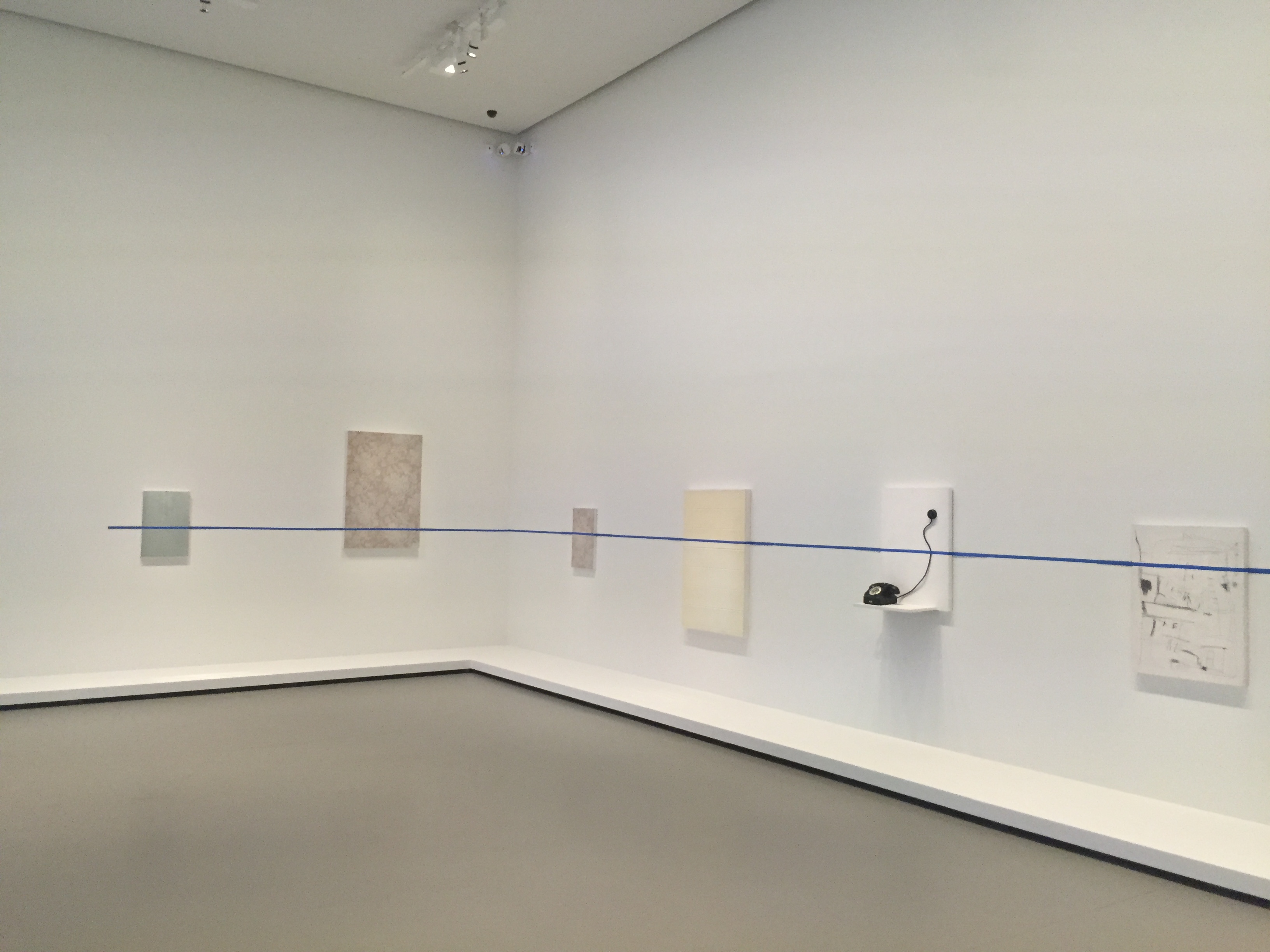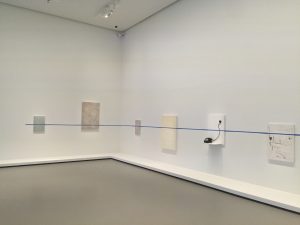Installation by Edward Krasinski
In this artwork, a blue tape is invading 9 works, each very symbolic. The artist’s tendency of marking his own territory with tape is revealed through this installation. He once said: “Wolves pee to mark their territory. I stick the blue tape to mark mine.”
This installation, invading two walls, is constituted of 9 works–either a piece of apartment or the world beyond–connected to each other in a progression from interior to exterior, or vice versa, with a blue tape. The line of blue tape is layered to each of the photographs and continues onto the wall. The first work entitled “Miror”, starting from the left, is a mirror. The second and the third ones, respectively entitled “Tenture II” and “Tenture”, are hangings constituted of wallpaper. The fourth one entitled “Salle de bain” is a bathroom tile made of plastic board. The fifth one, entitled “Intervention with a Phone”, is a telephone displayed on a white surface. The sixth one entitled “Permis de la fille” is a kid’s pencil drawing. The seventh one entitled “Map of Warsaw” is a map of Warsaw, on paper. The eighth one entitled “No.124” is a painted metal plate. The last one entitled “Beton gris” is a block of concrete. The common materials to all the works are synthetic polymer paint, wood, fiberboard, and steel– with the only exception of the last one, that isn’t made out of paint. The lighting of this installation depends on the lighting of the space. The artist’s main focus isn’t on light, but on the blue tape invading a space, attached to the wall on a height of 130 centimeters.
Krasinski made this artwork in 1972, in Poland. At the time, the regime was communist, as the country was controlled by the Soviet Union. His installation reminds us of the domestic space of communist-era housing blocks, where he used to live back then.
I chose to write about this artwork because it reminds me of two of the previous assignments for this class. Our first assignment was to build a map of our derive in the Tuileries Garden. I find that this artwork is like a map of his life, lived during the communist time of his country. The blue tape reminds me of his taken directions; he lived in plain apartments owned by the government of Warsaw, he struggled with the communication through telephones that wasn’t very easy because everything was controlled and censored, and lived in an environment of labor. On the drawing of the child, I can read either labyrinth or labor, which can be interpreted as there’s no way to shut down communism. Our second assignment was to make the environmental portrait of one of our classmates. For me, this installation represents the environment of the artist (life lived in a communist country) and therefore reveals some traits of his portrait.
The blue tape could be interpreted as being a metaphor of the dictators’ dominations, or a metaphor of his will to mark his own territory, to show that the life he lived is under his own property. The blue color of the tape is a color of hope that reminds us of the blue sky.
What makes this work powerful is the fact that it is taking over a huge space which could grasp the attention of the viewers more easily. Similarly, the fact of using tape as to mark a territory is powerful: the 9 different works are no longer separated, they contribute to a same meaning. In addition, the way the tape is displayed is very childish and unique; it reminds the viewers of the story of The Little Tumbling , who used stones to mark a trail that enables him to successfully lead his brothers back home. In this case, the tape helps the viewers to follow a certain order in the observation of the different works. However, the weakness of this installation is that the displayed works are so different that the viewers can get lost in the understanding of the meaning behind the piece.

